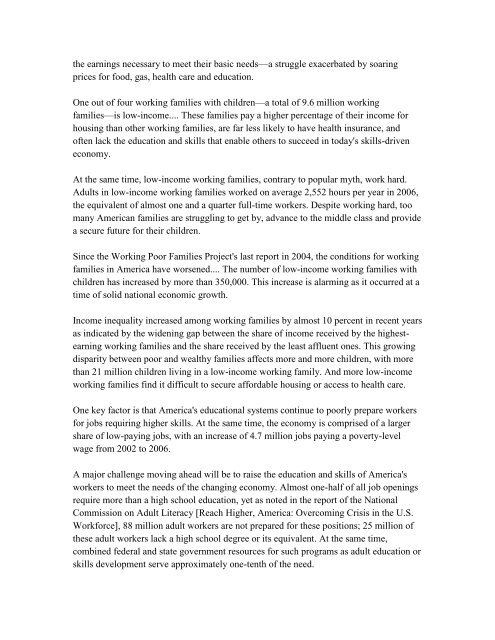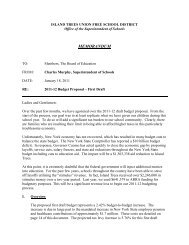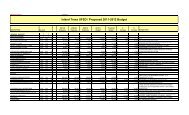Dear Incoming 10 Grade Student, We are excited to share this year's ...
Dear Incoming 10 Grade Student, We are excited to share this year's ...
Dear Incoming 10 Grade Student, We are excited to share this year's ...
You also want an ePaper? Increase the reach of your titles
YUMPU automatically turns print PDFs into web optimized ePapers that Google loves.
the earnings necessary <strong>to</strong> meet their basic needs—a struggle exacerbated by soaring<br />
prices for food, gas, health c<strong>are</strong> and education.<br />
One out of four working families with children—a <strong>to</strong>tal of 9.6 million working<br />
families—is low-income.... These families pay a higher percentage of their income for<br />
housing than other working families, <strong>are</strong> far less likely <strong>to</strong> have health insurance, and<br />
often lack the education and skills that enable others <strong>to</strong> succeed in <strong>to</strong>day's skills-driven<br />
economy.<br />
At the same time, low-income working families, contrary <strong>to</strong> popular myth, work hard.<br />
Adults in low-income working families worked on average 2,552 hours per year in 2006,<br />
the equivalent of almost one and a quarter full-time workers. Despite working hard, <strong>to</strong>o<br />
many American families <strong>are</strong> struggling <strong>to</strong> get by, advance <strong>to</strong> the middle class and provide<br />
a secure future for their children.<br />
Since the Working Poor Families Project's last report in 2004, the conditions for working<br />
families in America have worsened.... The number of low-income working families with<br />
children has increased by more than 350,000. This increase is alarming as it occurred at a<br />
time of solid national economic growth.<br />
Income inequality increased among working families by almost <strong>10</strong> percent in recent years<br />
as indicated by the widening gap between the sh<strong>are</strong> of income received by the highestearning<br />
working families and the sh<strong>are</strong> received by the least affluent ones. This growing<br />
disparity between poor and wealthy families affects more and more children, with more<br />
than 21 million children living in a low-income working family. And more low-income<br />
working families find it difficult <strong>to</strong> secure affordable housing or access <strong>to</strong> health c<strong>are</strong>.<br />
One key fac<strong>to</strong>r is that America's educational systems continue <strong>to</strong> poorly prep<strong>are</strong> workers<br />
for jobs requiring higher skills. At the same time, the economy is comprised of a larger<br />
sh<strong>are</strong> of low-paying jobs, with an increase of 4.7 million jobs paying a poverty-level<br />
wage from 2002 <strong>to</strong> 2006.<br />
A major challenge moving ahead will be <strong>to</strong> raise the education and skills of America's<br />
workers <strong>to</strong> meet the needs of the changing economy. Almost one-half of all job openings<br />
require more than a high school education, yet as noted in the report of the National<br />
Commission on Adult Literacy [Reach Higher, America: Overcoming Crisis in the U.S.<br />
Workforce], 88 million adult workers <strong>are</strong> not prep<strong>are</strong>d for these positions; 25 million of<br />
these adult workers lack a high school degree or its equivalent. At the same time,<br />
combined federal and state government resources for such programs as adult education or<br />
skills development serve approximately one-tenth of the need.
















